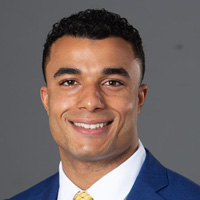You Got That New Job: Now It’s Time to Make the Right Financial Choices
Young professionals are on the move. If you’ve made a switch or have one on the horizon, follow this checklist to keep your finances on track.


Millions of Americans will start new jobs this year. With the pandemic drastically changing how, when and where we work, a fall 2020 survey by resources software company Ceridian found that sixty-four percent of all workers were actively looking or open to a new opportunity. The survey also found that a whopping 76% of workers under age 30 fell into this category.
I happen to be one of those young professionals who made a career change during the pandemic. Moving from Philadelphia to Charlotte, N.C., the opportunity to live where I want and do work that I’m passionate about was too appealing to pass up. However, as anyone who has ever started a new job knows, employment changes don’t come without challenges.
Aside from learning new responsibilities, accepting a new job also creates a laundry list of financial decisions to work through. For instance, I had to figure out what to do with my old 401(k), which health care benefits to elect, and choose between making traditional or Roth contributions into my new 401(k). Even for a financial planner, the litany of decisions can quickly become overwhelming.

Sign up for Kiplinger’s Free E-Newsletters
Profit and prosper with the best of expert advice on investing, taxes, retirement, personal finance and more - straight to your e-mail.
Profit and prosper with the best of expert advice - straight to your e-mail.
If you’re starting a new job or considering a career change, here are five recommendations that will help ensure your personal finances are taken care of and allow you to focus on mastering your new role.
Determine When Your Old Health Coverage Ends and New Coverage Begins
Some employers will cover terminated employees for the remainder of the calendar month in which they leave. For example, if your last day is June 15, coverage would remain through June 30. The new employer may allow you to be covered on your start date, but may also have another coverage start date like the 1st of the month following your start date.
Don’t get caught without coverage, even only for a few days. If possible, work with human resources at both companies to learn their policies before giving notice to your current employer so you can coordinate your coverage within COBRA guidelines. Otherwise, you may need to look into a short-term health insurance policy to bridge any gaps.
Choose the Right Health Care Benefits
With health care plans constantly changing, start by paying attention to the various deductible amounts. A great rule of thumb is to always have at least enough cash on hand to cover your highest deductible in case of emergency.
Additionally, be sure to account for the potential needs of any covered dependents. If you or a dependent has a medical condition that requires regular doctor’s visits or prescriptions, it may be worth paying for the slightly more expensive option.
You’ll also want to give careful consideration to optional life insurance or long-term disability coverage. One of the biggest and most often neglected risks for young professionals is losing your ability to earn an income over the coming decades. Protecting yourself and your loved ones with disability insurance is almost always the financially responsible choice.
Lastly, if you choose a high deductible health plan (HDHP), enroll in a health savings account (HSA). HSAs receive what is known as “triple tax-advantaged” treatment, meaning contributions are tax deductible when they’re made, funds can be invested on a tax-deferred basis, and distributions are income-tax free if used to pay for qualified medical expenses. Note that the IRS requires individuals to be covered by a HDHP to be eligible to contribute to an HSA.
Your employer may even make HSA contributions on your behalf if you participate in certain wellness activities, such as health screenings, so be sure to inquire about how you can potentially qualify for free money.
Know Your Old Employer’s Policy on Vacation Payout
Many companies will pay departing employees for unused vacation days. In my case, I had nearly 25 days of unused vacation when I left my last job, for which I received more than $5,000 in addition to my final paycheck. Even if you only have a few days accrued, I strongly recommend contacting your HR representative prior to your last day to inquire about your vacation balance, the amount you’re entitled to as your payout, and when you can expect to receive it.
Conversely, be aware the opposite can be true if you have previously used vacation time that has not yet been accrued. In these instances, you’ll likely be obligated to pay the company back via a reduction from your last paycheck (assuming your paycheck covers the amount owed).
Enroll in Your New Employer’s 401(k) Retirement Plan
Find out when you can enroll in the new employer’s plan and do so as soon as you’re eligible. Despite many companies adopting automatic enrollment policies, don’t rely on this alone. Many such programs automatically enroll new hires at fairly modest contribution rates, such as 3% or 5% of pay, which can serve as a starting point, but will not be enough to achieve retirement and financial independence goals for most individuals.
Many financial experts agree that saving 15% between your employer’s retirement plan and other retirement accounts is sufficient; however, I believe 20%-25% is ideal. Even if that’s not feasible just yet, it’s crucial that you contribute at least the amount required to receive your full employer match. Yet another plug for free money!
It’s also worth noting that people in lower tax brackets – at or below roughly 25%, including federal and state taxes – might consider making Roth contributions if their 401(k) plan permits them. Unlike “traditional” or pre-tax contributions, Roth contributions are made with after-tax money, which then grow tax-deferred and allow for tax-free distributions in retirement.
Finally, don’t forget to select your investments. For the majority of young professionals, a target date retirement fund can be a solid option. Just pick the retirement year that aligns with your goals, set it and forget it.
Roll Over Your Old 401(k) Account
Many young professionals have tens of thousands of dollars in their former employers’ 401(k) plans. Don’t let these accounts sit idle for long – they’re easy to forget about and much more difficult to manage when your money is in numerous places. Like many of my friends, I avoided rolling over my 401(k) for over a year after leaving my first job out of fear that it would be stressful and time-consuming. Much to my pleasant surprise, it took less than 20 minutes to fill out a few simple forms, initiate the transfer, and have my money invested within a couple business days.
One rollover method you might consider is rolling the money from the old account into your new 401(k), if your new plan allows incoming rollovers. Most 401(k) providers offer online account access and provide step-by-step instructions on the rollover process. It’s really not as scary as it sounds – just be sure to elect a “Direct Rollover” and not a distribution.
Your other option would be to roll the money into a new or existing IRA. Opening a rollover IRA is easy and can be done through an online brokerage firm in a matter of minutes.
Last, and most importantly, do not cash out these accounts. Regardless of the amount, cashing out will result in unnecessary taxes, penalties, and ultimately robbing your future self of a more enjoyable retirement.
Starting a new job is an exciting time, full of hope and opportunity. By making the right financial decisions, you can enjoy a fulfilling career while also building substantial personal wealth. Take time during those first few weeks on the job to study your options, put a strategy in place, and set yourself up for long-term financial success.
Get Kiplinger Today newsletter — free
Profit and prosper with the best of Kiplinger's advice on investing, taxes, retirement, personal finance and much more. Delivered daily. Enter your email in the box and click Sign Me Up.

As an Associate Wealth Adviser at CI Brightworth, Jalen P. Randolph is passionate about helping high-earning professionals maximize their unique wealth-building opportunities through personal planning and advice. Prior to joining CI Brightworth, Jalen worked in both financial services and non-profit development. He earned his bachelor of science and master's of business administration degrees from the University of Delaware.
-
 Should You Get Earthquake Insurance?
Should You Get Earthquake Insurance?Standard home insurance doesn’t cover earthquakes, but paying extra for earthquake insurance isn’t just for Californians.
By Rachael Green
-
 Stock Market Today: Dow Drops 699 Points After Powell Speech
Stock Market Today: Dow Drops 699 Points After Powell SpeechFed Chair Powell warned of a slowing economy and higher inflation but said the central bank isn't ready to cut rates just yet.
By Karee Venema
-
 A QLAC Does So Much More Than Simply Defer Taxes
A QLAC Does So Much More Than Simply Defer TaxesHere are the multiple ways you can use a QLAC, from managing retirement risks to creating income for specific retirement needs and wants.
By Jerry Golden, Investment Adviser Representative
-
 Self-Directed Brokerage Accounts: Retirement's Hidden Gem?
Self-Directed Brokerage Accounts: Retirement's Hidden Gem?SDBAs are often overlooked, but they can offer more flexibility and growth potential inside your 401(k) when actively managed by a professional.
By Scott M. Dougan, RFC, Investment Adviser
-
 Early-Stage Startup Deals: How Does a SAFE Work?
Early-Stage Startup Deals: How Does a SAFE Work?Investing in an early-stage startup can get complicated fast, so the venture capital industry turns to other investing options. One is a SAFE.
By Murat Abdrakhmanov
-
 Should You Hire a Public Adjuster for Your Insurance Claim?
Should You Hire a Public Adjuster for Your Insurance Claim?As natural disasters strike more often, insurance clients are asking, 'What should I do, or who should I hire, if my insurance company is jerking me around?'
By H. Dennis Beaver, Esq.
-
 Tips to Help Entrepreneurs Create Self-Sustaining Businesses
Tips to Help Entrepreneurs Create Self-Sustaining BusinessesWith the right processes and people in place, a truly sustainable business can be efficiently passed on to a successor and run profitably on its own.
By Jason L Smith, CEP®, BPC
-
 Navigating Annuity Taxation: A Guide for Financial Advisers
Navigating Annuity Taxation: A Guide for Financial AdvisersUnderstanding the essentials of taxation in retirement income strategies involving annuities helps ensure positive outcomes for clients.
By Jake Klima
-
 How Google Reviews Can Help (or Hurt) Financial Advisers
How Google Reviews Can Help (or Hurt) Financial AdvisersDon't leave your Google Business Profile unclaimed — someone else can make changes if they claim it. Also, here's what you can (and cannot) do with the reviews.
By Jeff Briskin
-
 How Baby Boomers and Gen Xers Are Redefining Retirement Living
How Baby Boomers and Gen Xers Are Redefining Retirement LivingBoth generations need to embrace change and leverage real estate as a dynamic asset in their retirement planning. Here's how financial advisers can help, too.
By David Conti, CPRC